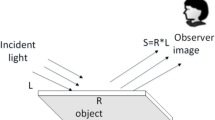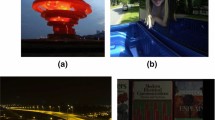Abstract
Proper contrast and sufficient illuminance are important in clearly identifying the retinal structures, while the required quality cannot always be guaranteed due to major reasons like acquisition process and diseases. To ensure the effectiveness of enhancement, two solutions are developed for blurry retinal images with sufficient illuminance and insufficient illuminance, respectively. The proposed contrast stretching and intensity transfer are main steps in both of the two solutions. The contrast stretching is based on base-intensity removal and non-uniform addition. We assume that a base-intensity exists in an image, which mainly supports the basic illuminance but has less contribution to texture information. The base-intensity is estimated by the constrained Gaussian function and then removed. The non-uniform addition using compressed Gamma map is further developed to improve the contrast. Additionally, an effective intensity transfer strategy is introduced, which can provide required illuminance for a single channel after contrast stretching. The color correction can be achieved if the intensity transfer is performed on three channels. Results show that the proposed solutions can effectively improve the contrast and illuminance, and good visual perception for quality degraded retinal images is obtained.

Illustration of contrast stretching based on a signal colour channel.















Similar content being viewed by others
References
Cao L, Li H, Zhang Y, Zhang L, Xu L (2020) Hierarchical method for cataract grading based on retinal images using improved Haar wavelet. Inform Fusion 53:196–208. https://doi.org/10.1016/j.inffus.2019.06.022
** K, Zhou M, Wang S, Lou L, Qian D (2017) Computer-aided diagnosis based on enhancement of degraded fundus photographs. Acta Ophthalmol 96(3):e320. https://doi.org/10.1111/aos.13573
Abramoff M, Garvin M, Sonka M (2010) Retinal imaging and image analysis. IEEE Rev Biomed Eng 3:169–208. https://doi.org/10.1109/RBME.2010.2084567
Gupta B, Tiwari M (2019) Color retinal image enhancement using luminosity and quantile based contrast enhancement. Multidim Syst Sign Process 18:1–9. https://doi.org/10.1007/s11045-019-00630-1
Yan Z, Yang X, Cheng K (2018) Joint segment-level and pixel-wise losses for deep learning based retinal vessel segmentation. IEEE Trans Biomed Eng 65(9):1912–1923. https://doi.org/10.1109/TBME.2018.2828137
Yang J, Li J, Shen R (2016) Exploiting ensemble learning for automatic cataract detection and grading. Comput Methods Programs Biomed 124(C):45–57. https://doi.org/10.1016/j.cmpb.2015.10.007
**ong L, Li H, Xu L (2017) An approach to evaluate blurriness in retinal images with vitreous opacity for cataract diagnosis. J Healthcare Eng 34:1–16. https://doi.org/10.1155/2017/5645498
Kaur J, Mittal D (2018) A generalized method for the segmentation of exudates from pathological retinal fundus images. Biocybern Biomed Eng 38(1):27–53. https://doi.org/10.1016/j.bbe.2017.10.003
Soorya M, Lssac A, Dutta M (2018) An automated and robust image processing algorithm for glaucoma diagnosis from fundus images using novel blood vessel tracking and bend point detection. Int J Med Inform 110:52–70. https://doi.org/10.1016/j.ijmedinf.2017.11.015
Bekkers E, Duits R, Berendschot T, Romeny B (2014) A multi-orientation analysis approach to retinal vessel tracking. J Math Imaging Vision 49(3):583–610. https://doi.org/10.1007/s10851-013-0488-6
Bock R, Nyul M, Hornegger J, Michelson G (2010) Glaucoma risk index: automated glaucoma detection from color fundus images. Med Image Anal 14(3):471–481. https://doi.org/10.1016/j.media.2009.12.006
Giancardo L, Meriaudeau F, Karnowski TP (2011) Exudate based diabetic macular edema detection in fundus images using publicly available datasets. Med Image Anal 16(1):216–226. https://doi.org/10.1016/j.media.2011.07.004
Guo L, Yang J, Peng L, Li J, Liang Q (2015) A computer aided healthcare system for cataract classification and grading based on fundus image analysis. Comput Ind 69(C):72–80. https://doi.org/10.1016/j.compind.2014.09.005
He K, Georgia G, Piotr D, Ross G (2018) Mask R-CNN. IEEE Trans Pattern Anal Mach Intell. https://doi.org/10.1109/TPAMI.2018.2844175
Mookiah M, Acharya U, Chua C, Lim C, Ng E, Laude A (2013) Computer-aided diagnosis of diabetic retinopathy: a review. Comput Biol Med 43(12):2136–2155. https://doi.org/10.1016/j.compbiomed.2013.10.007
Sheng B, Li P, Mo S (2018) Retinal vessel segmentation using minimum spanning superpixel tree detector. IEEE Trans Cybern 99:1–13. https://doi.org/10.1109/TCYB.2018.2833963
Zhang J, Dashtbozorg B, Bekkers E, Pluim J, Duits R, Romeny B (2016) Robust retinal vessel segmentation via locally adaptive derivative frames in orientation scores. IEEE Trans Med Imaging 35(12):2631–2644. https://doi.org/10.1109/TMI.2016.2587062
Zhang J, Li H (2014) A retinal vessel boundary tracking method based on Bayesian theory and multi-scale line detection. Comput Med Imaging Graph 38(6):517–525. https://doi.org/10.1016/j.compmedimag.2014.05.010
Mitra A, Roy S, Roy S, Setua S (2018) Enhancement and restoration of non-uniform illuminated fundus image of retina obtained through thin layer of cataract. Comput Methods Programs Biomed 156:169–178. https://doi.org/10.1016/j.cmpb.2018.01.001
Wang S, Luo G (2018) Naturalness preserved image enhancement using a priori multi-layer lightness statistics. IEEE Trans Image Process 27(2):938–948. https://doi.org/10.1109/TIP.2017.2771449
**ong L, Li H, Xu L (2017) An enhancement method for color retinal images based on image formation model. Comput Methods Programs Biomed 143:137–150. https://doi.org/10.1016/j.cmpb.2017.02.026
Zhou M, ** K, Wang S, Ye L, Qian D (2018) Color retinal image enhancement based on luminosity and contrast adjustment. IEEE Trans Biomed Eng 65(3):521–527. https://doi.org/10.1109/TBME.2017.2700627
Nguyen U (2013) An effective retinal blood vessel segmentation method using multi-scale line detection. Pattern Recogn 46(3):703–715. https://doi.org/10.1016/j.patcog.2012.08.009
Liu H, Huang M, Cui G, Luo M, Melgosa M (2013) Color-difference evaluation for digital images using a categorical judgment method. J Opt Soc Am A-Optics Image Sci Vision 30(4):616–626. https://doi.org/10.1364/JOSAA.30.000616
Author information
Authors and Affiliations
Corresponding author
Additional information
Publisher’s note
Springer Nature remains neutral with regard to jurisdictional claims in published maps and institutional affiliations.
Rights and permissions
About this article
Cite this article
Cao, L., Li, H. Enhancement of blurry retinal image based on non-uniform contrast stretching and intensity transfer. Med Biol Eng Comput 58, 483–496 (2020). https://doi.org/10.1007/s11517-019-02106-7
Received:
Accepted:
Published:
Issue Date:
DOI: https://doi.org/10.1007/s11517-019-02106-7




